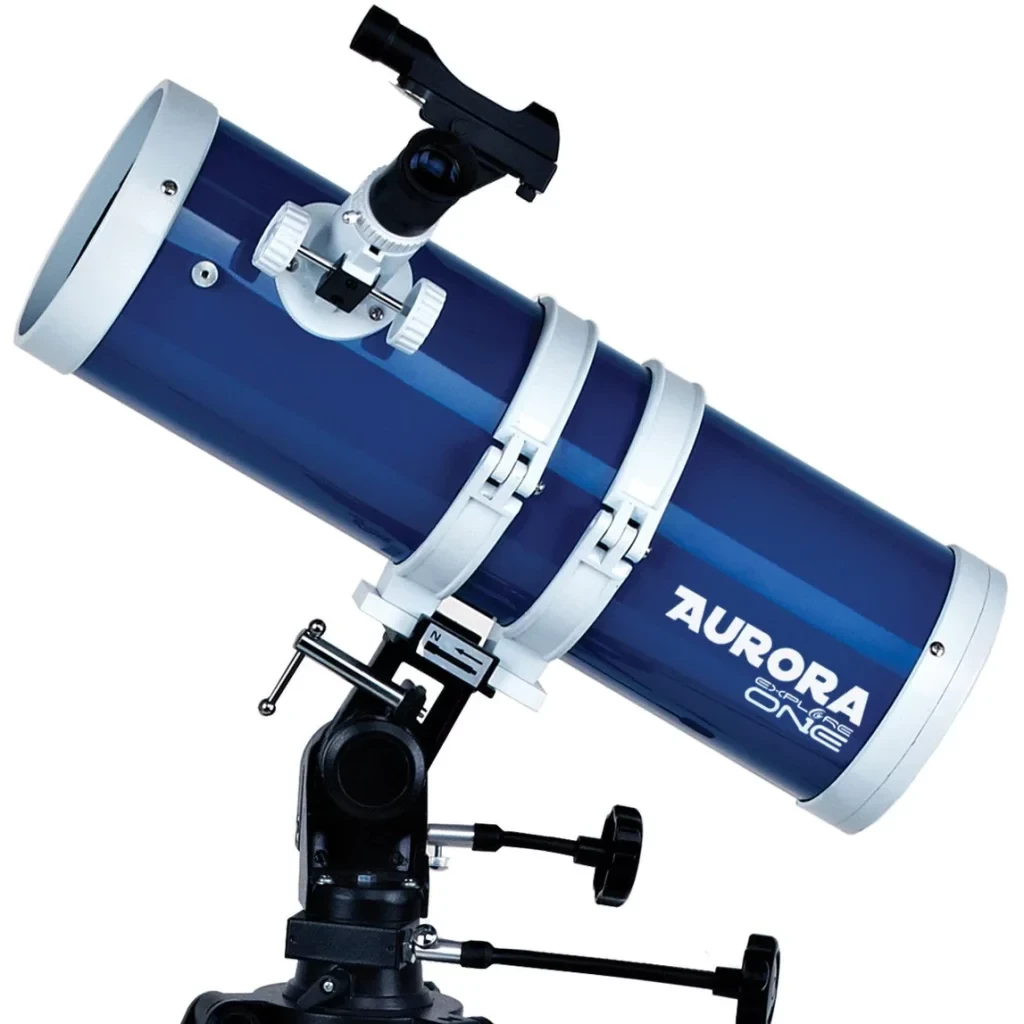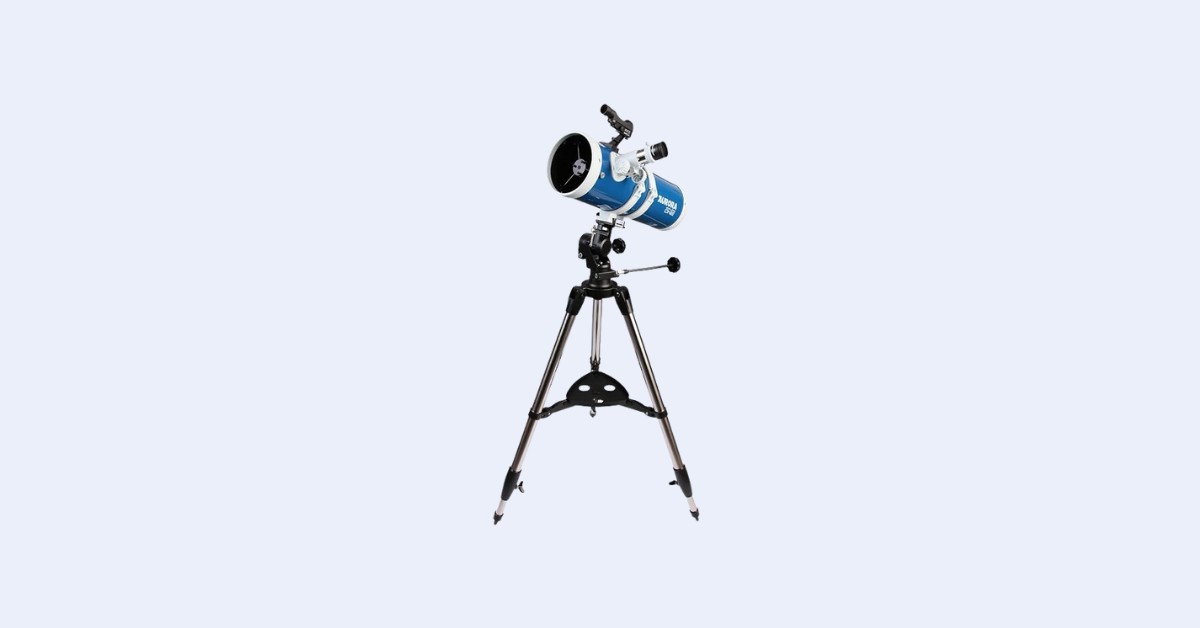The Optical Tube
The Explore One Aurora 114 is a 114mm (4.5”) f/4.4 Newtonian reflector with a resulting focal length of 500mm. This is slightly longer than the 450mm focal length of most fast 114mm reflectors. Fortunately, the primary mirror is parabolic, which is not always the case with low-cost, fast-reflecting telescopes. A parabolic primary mirror is required to form sharp images, and the Aurora 114 has no trouble doing just that.
At f/4.4, collimation is fairly important; unfortunately, the Aurora 114 must be collimated with a screwdriver, which is rather annoying to do in the field, though it will hold collimation fairly well once adjusted properly. No collimation tools are included with the Aurora 114; find out more about how to make or where to buy a suitable one in our collimation guide. An f/4.4 reflector has some coma and other edge-of-field aberrations visible at the edges of the field of view with cheap, low-power eyepieces, though it may not be enough to be bothersome.

The focuser on the Aurora is a plastic 1.25” rack-and-pinion design. There is a little bit of wobble and backlash, but it works fine at all but the highest magnifications.
To attach to its mount, the Aurora 114 uses a pair of standard tube rings, which allow you to slide and rotate the tube for balance. They’re bolted to a Vixen-style dovetail plate, which is interchangeable quickly and easily with almost any other astronomical mount you would want to use the Aurora 114 on.
Accessories
The Explore One Aurora 114mm Reflector includes two 1.25” Plossl eyepieces: a 26mm providing 20x magnification and a 9.7mm for 52x. While the Plossl design is capable of providing sharp images, these eyepieces are unusually cheap (though thankfully the optics are still glass). The apparent field of view of both is a bit less than 50 degrees, and they suffer from glare and ghost images. The 9.7mm is also rather short on eye relief, forcing you to jam your eye into it to take in the full (albeit narrow) field of view. There are certainly worse eyepieces, but these aren’t fabulous ones either. We would consider the 26mm acceptable enough; the 9.7mm is noticeably a less-than-stellar experience compared to a more expensive and high-quality eyepiece.
The finder provided with the Aurora 114 is an extremely low-quality red-dot sight with a tinted window, a tiny switch, and a lot of difficulty making fine adjustments. As a result, aiming the Aurora 114 with precision can be somewhat difficult.
Mount
The Explore One Aurora 114 uses an alt-azimuth mount and tripod with many similarities to a photo tripod. The optical tube and rings slide into its Vixen-style dovetail saddle, and the scope pivots up and down as well as left to right. There’s a lock/tension adjustment on the altitude axis that you’ll wind up using a lot, as the Aurora mount design has the optical tube outboard of the center of rotation, and thus it will not stay in place if aimed high in the sky without locking up the altitude motions. Both the altitude and azimuth axes of the Aurora 114’s mount have slow-motion gearing and cables for fine adjustments for aiming and tracking objects with the telescope. The cables have some backlash but work reasonably well.
The Aurora 114’s mount is attached to a steel-legged tripod, which is reasonably steady, though the scope can be a little jiggly at high magnifications with the legs extended all the way. There’s an accessory tray that snaps into place in the middle of the tripod legs; placing something heavy on the tray to lower the center of gravity of the telescope will help to reduce unwanted vibrations.
Should I buy a Used Explore One Aurora 114?
I believe a used Aurora 114 should be just fine, as there’s little to go wrong apart from damage to the mirror coatings or plastic focuser. Missing accessories can be replaced, though the cost compared to a new telescope is something to consider. Always make sure that in any used reflecting telescope the mirrors are free of obvious cracks or corrosion to the coatings, as recoating is not cost-effective with smaller instruments.
Alternative Recommendations
The Explore One Aurora 114 isn’t the worst choice, but we’d prefer a Dobsonian instead if one is available. Here are some of our top picks for alternative telescopes around the price of the Aurora 114.
Under $250
- The Zhumell Z100 and Orion SkyScanner 100 have less aperture than the Aurora 114, but are significantly faster to set up, offer a slightly wider field of view, include better accessories, and can even be attached to a suitable photo tripod if need be.
- The Zhumell Z114 has similar performance to the Aurora 114 but offers a wider field of view, tool-free adjustment of the primary mirror for collimation, high-quality accessories and the simplicity of a tabletop Dobsonian mount.
- The Orion StarBlast II 4.5 EQ has the same optical tube as the Aurora 114 but slightly better quality included accessories and a more versatile – if complicated and equally unsteady – equatorial mount.
$250-$350
- The Sky-Watcher Heritage 150P offers significantly more aperture – and thus performance gains – over the Aurora 114, its provided eyepieces and red dot finder are high quality, and its collapsible tube and tabletop Dobsonian mount make it extremely portable and easy to use. A computerized version, the Virtuoso GTi 150P, is also available at a higher price tag.
- The Sky-Watcher Heritage 130P uses the same design and comes with the same great accessories and features as the Heritage 130P, but with a slightly lower price tag and smaller aperture – though still vastly outperforming a 114mm reflector.
- The Orion StarBlast 4.5 Astro is essentially identical to the Zhumell Z114 and usually priced higher, though it can be a good deal if you can’t obtain a Z114 or larger instrument at a comparable price.
Aftermarket Accessory Recommendations
The Explore One Aurora 114’s eyepieces are acceptable enough that replacing them is a little redundant, especially the 26mm, which is just fine if you aren’t using it on very bright objects. In any case, they don’t provide the full range of magnifications that you might want to use with this telescope.
A 15mm SWA or redline eyepiece will provide 33x magnification with the Aurora 114, ideal for viewing most deep-sky objects as opposed to low-power scanning with the 26mm. A 6mm goldline or redline eyepiece provides 83x, ideal for viewing the Moon and planets though hardly pushing the capabilities of the Aurora 114’s optics. A 3.2mm planetary eyepiece provides 156x with the Aurora 114, about as high magnification as you can realistically expect to benefit from using with this size telescope and typical viewing conditions.
A replacement, higher-quality red dot finder for the Aurora 114 is easy to install and significantly eases the frustration of aiming the telescope at most targets, though it’s annoying that this generic device isn’t just provided by default.
A UHC (ultra high contrast) nebula filter, such as the Orion 1.25” UltraBlock filter, will improve views of many nebulae with the Aurora 114 by increasing the contrast between your target and the background sky, especially under light-polluted conditions, simply by screwing onto your low-power eyepiece
What can you see with ExploreOne Aurora 114?
The Aurora 114 is dependent on your light pollution conditions when it comes to its capabilities for viewing deep-sky objects, as is the case with any telescope. The good news is that open star clusters are usually fairly easy to spot even from suburban or city skies, such as the Double Cluster or the Pleiades (M45). The brighter and less compact globular star clusters like M3, M13, and M22 can just barely be resolved under somewhat dark skies with the Aurora 114 using high magnifications of around 80x or more. Most planetary nebulae will be invisible or tiny star-like smudges, but a few, like the Ring (M57) can be seen, and the Blinking Planetary will do its eponymous trick for you at high magnifications. Larger planetaries like the Dumbbell (M27) and Helix do best with dark skies, low power, and/or a UHC nebula filter.
While affected by light pollution, emission nebulae like the Orion Nebula (M42) and Lagoon (M8) can be seen with the Aurora 114 even from the suburbs and contain glittering open star clusters, while the fainter Swan (M17) and Eagle (M16) look best under dark skies. A UHC nebula filter helps tremendously with these objects and brings out previously-unseen others like the North America Nebula, the Veil Nebula supernova remnant, and the Crab Nebula (M1) supernova remnant under suitably dark skies.
The small aperture of the Aurora 114 is going to be a bit of a letdown on galaxies; many disappear from view altogether under light-polluted skies, and only the brightest ones show detail, namely the high-contrast dust lanes in objects like M31, M64, and M82. Galaxy groups and clusters like the elliptical galaxies orbiting M31, the Leo Triplet, or the Virgo Cluster – the latter containing a few dozen members visible under dark skies with the Aurora 114 – can also be spotted.
The Explore One Aurora 114 does well on Solar System objects, though a magnification significantly higher than the mere 52x provided by the stock 9.7mm Plossl eyepiece is best for viewing details. You can see the polar ice caps and a few dark markings on Mars when it’s close to Earth, along with the phases of Mercury and Venus and many thousands of details like mountains, ridges, craters and fault lines on the Moon’s jagged surface. The moons of Jupiter can be seen, along with their disks and jet-black shadows whenever they transit in front of the planet, and Jupiter itself shows many colorful storms, cloud belts, and the Great Red Spot, which are always changing in appearance week by week – though the constantly-shrinking Great Red Spot may be hard to pick out even at high magnification on a less-than-steady night.
The rings of Saturn and the slim Cassini Division within them are a delight with the Aurora 114, and you can also see details such as Saturn’s cloud belts, its shadow on the rings, and a few moons orbiting it, such as Titan, Rhea, Tethys, and Dione. The disk of Uranus can be barely resolved at high power, though its moons are too faint to see and any detail in its clouds is too small to resolve with the Aurora 114. Neptune is hard to distinguish from a star at all, and its moon Triton is just beyond the reach of the Aurora 114, even under dark skies, as is distant and faint Pluto.




I own one of these telescopes but have heard conflicting opinions about whether its mirror is spherical or parabolic. Could you please tell me why you think it’s parabolic? Thank you.
I tested one and it is parabolized
Im kind of confused since amazon reviews say its spherical, how did you test it and confirm?
as at 2024-08-23, the official ES product page says: “using a high-precision spherical primary mirror” so they have engaged in corporate greed shenanigans and released a new inferior product under the same product name. https://www.explorescientific.com/products/aurora-ii-flat-black-114mm-slow-motion-az-mount-telescope It would be good to note this important change in the review notes, that a previous generation was tested; a new review might be needed…?
Will be updating soon : (
Except that Explore Scientific’s website says that the mirror is spherical.